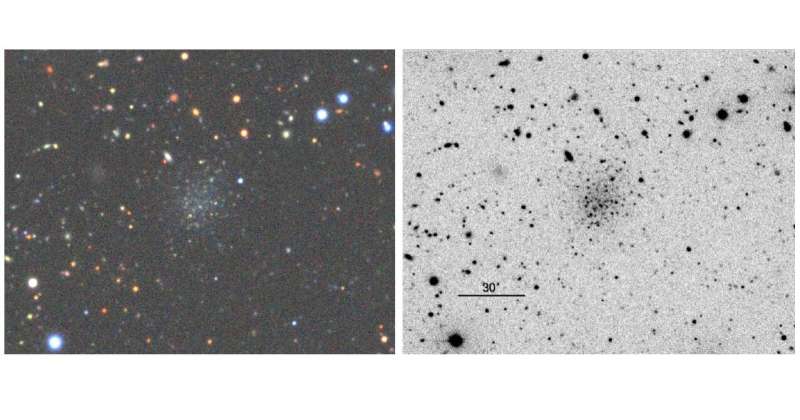May 26, 2022 report
New ultra-faint dwarf galaxy discovered

Astronomers from the University of Arizona (UA) and elsewhere report the discovery of a new ultra-faint dwarf galaxy. The newfound galaxy, designated Tucana B, is the first quenched and isolated object of this type identified in the extreme outskirts of the Local Group. The finding is reported in a paper published May 18 on the arXiv pre-print server.
The so-called ultra-faint dwarf galaxies (UFDs) are the least luminous, most dark-matter-dominated, and least chemically evolved galaxies known. Therefore, they are perceived by astronomers as the best candidate fossils from the universe at its early stages.
Now, a team of researchers led by UA's David J. Sand has found a new UFD during a visual search for faint dwarf galaxy companions to the distant dwarf spheroidal galaxy Tucana. They used data from the Dark Energy Spectroscopic Instrument (DESI) Legacy Imaging Surveys Data Release 9 and their interactive color image viewer.
"We uploaded a custom file to mark off a region with a projected radius of 100 kpc (≈6.4 deg at the distance of Tucana) and searched for visual over-densities of resolved stars with underlying diffuse light, indicative of a dwarf galaxy at the edge of the Local Group. The field was inspected at a variety of spatial scales and contrast levels. Tucana B stood out during the search, and is partially resolved into stars in the Legacy Imaging Survey viewer," the astronomers explained.
According to the paper, Tucana B is located about 6 degrees from the Tucana dwarf spheroidal, and is about 1.6 million light years more distant along the line of sight. The distance to Tucana B from the Earth was calculated to be approximately 4.5 million light years.
Tucana B has a half-light radius of some 260 light years, and an absolute magnitude of −6.9 mag, what makes it comparable to the ultra-faint satellite galaxies of the Milky Way. The UFD appears to only consist of an old metal-poor stellar population.
The astronomers noted that the luminosity of Tucana B and apparent lack of star formation and also neutral gas make it unique among recent discoveries at this approximate distance. Moreover, the extreme isolation of Tucana B may indicate that its star formation was quenched by reionization or some other internal mechanism, rather than interaction with a larger galaxy halo.
Sand's team sees Tucana B as a great target for future space-based follow-up observations aiming to pin down its structure and star formation history, possibly down to the oldest main sequence turnoff.
"In particular, Tucana B may provide a definitive opportunity to understand the role that reionization plays in the quenching of the faintest galaxies," the researchers concluded.
They added that finding more objects like Tucana B is necessary in order to better understand the demographics of the field UFD population.
More information: D.J. Sand et al, Tucana B: An Isolated and Quenched Ultra-faint Dwarf Galaxy at D=1.4 Mpc. arXiv:2205.09129v1 [astro-ph.GA], arxiv.org/abs/2205.09129
© 2022 Science X Network





















